THE SETTLEMENT HOUSES
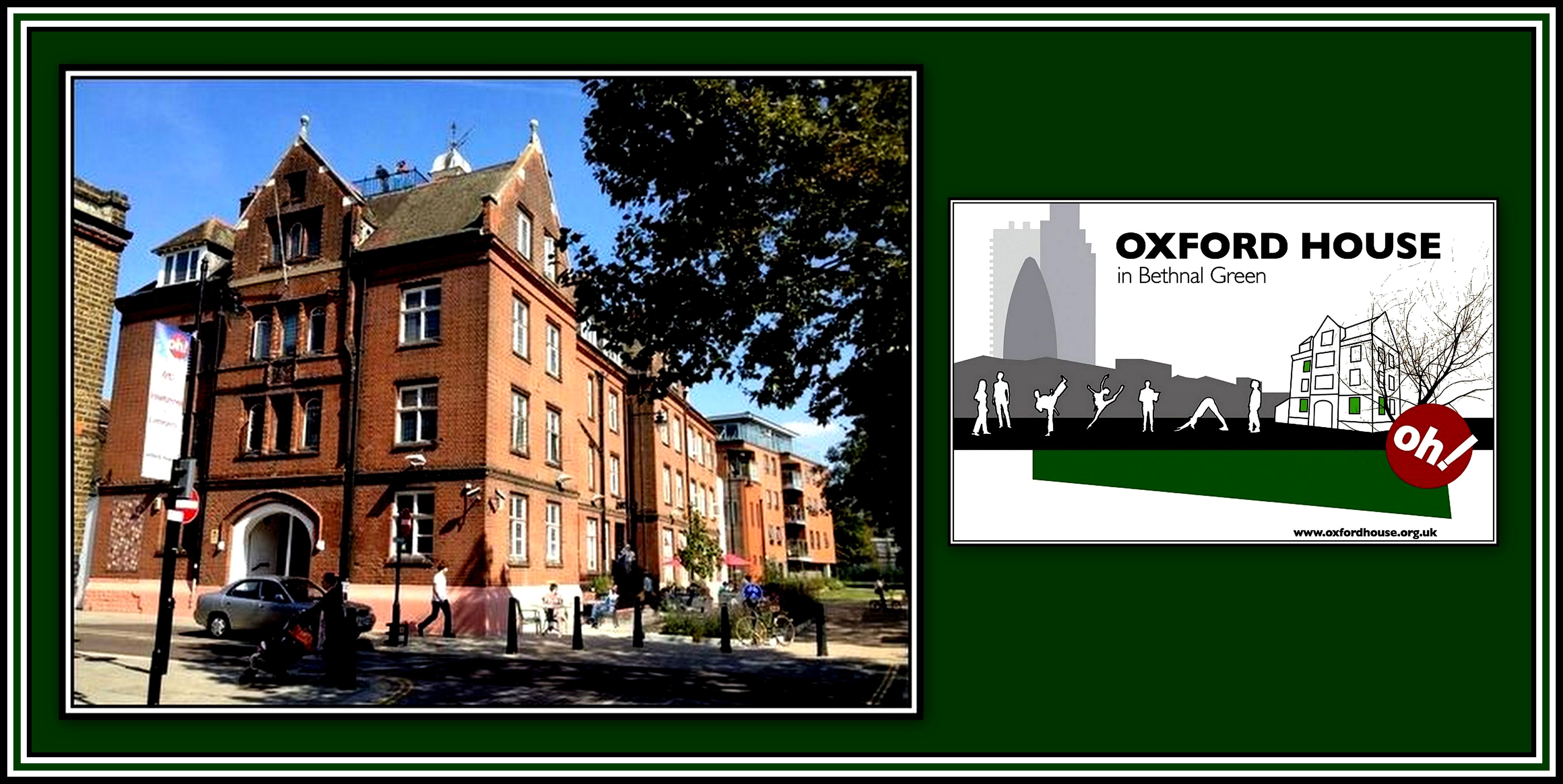 (The New) Oxford House on Derbyshire Street in Bethnal Green
(The New) Oxford House on Derbyshire Street in Bethnal Green
-oOo-
OXFORD HOUSE & THE WAR YEARS
THE TIMES BEGIN TO CHANGE

-oOo-
The number of graduates volunteering their time and efforts at Oxford House has been influenced by wars and the first to affect Oxford House was The Boer War.
The Second Boer War (1899-1902) was fought between what was then the British Empire and two independent Boer Republics of the Orange Free State and the South African Republic (Transvaal Republic). As with all wars, it was costly in terms of lost lives with ~75,000 lost: ~22,000 British Empire soldiers (7,792 in battle and the remainder, as the result of disease) and 6,000-7,000 Boer Commandos.
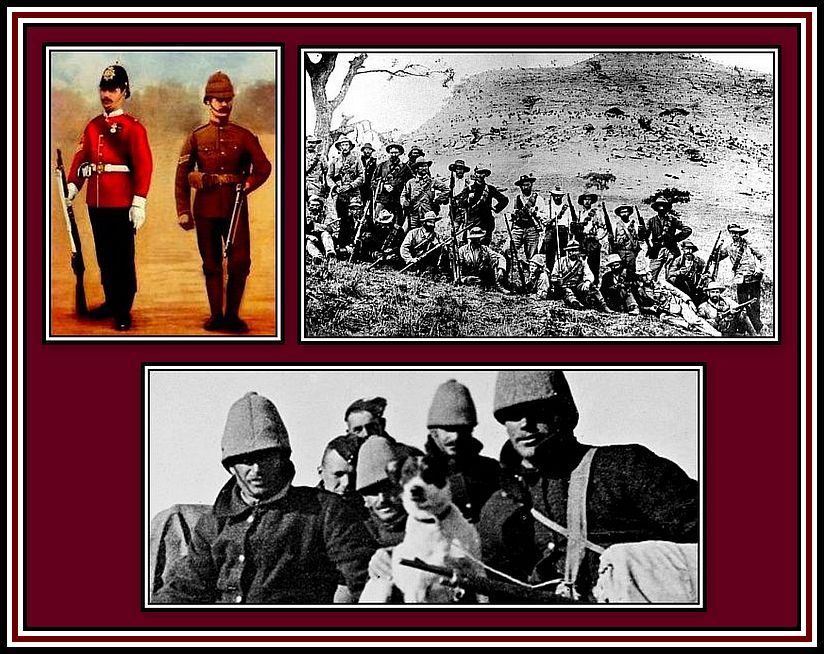 British Soldiers (Top Left & Bottom with their Dog) & Boers (Top Right) during The Boer War
British Soldiers (Top Left & Bottom with their Dog) & Boers (Top Right) during The Boer War
A number of residents of Oxford House joined the forces during the Boer War, and in 1901, the number of university graduates that came to volunteer was reduced to two.
-oOo-
In 1912, Oxford House founded a monthly periodical called, The Excelsior. During its publication, it had an average circulation of ~1,2000 copies. The Excelsior apparently supported the Local Government Board at times when trying to persuade the London County Council to introduce changes including speed limits etc. Unfortunately I have been unable to determine when the periodical ceased publication.
-oOo-
OXFORD HOUSE: THE FIRST WORLD WAR
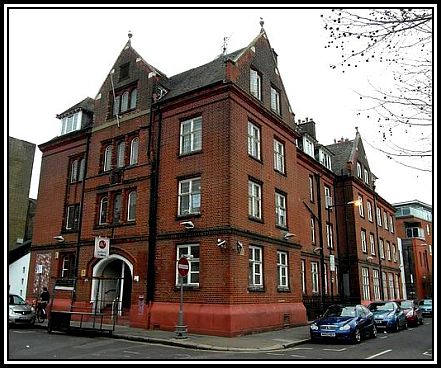
The effects of The First World War caused a reduction in the number of residents and workers at Oxford House and, as a result, brought about a reduction in the House’s income while increasing the demands on its funds.
Due to the demands being made on the local populace to enter the military, membership to the various Clubs and attendance at the events sponsored by Oxford House decreased during the First World War. Another major problem experienced during the war years was that it was difficult to find younger members among the boys of the area who were sufficiently reliable to be part of Club Committees.
With many men entering the military, the numbers attending the Clubs and events of Oxford House were decreased, Although revenue decreased, overhead costs did not. To help reduce overheads, The Webbe Club moved into Oxford House. Despite hard times, Oxford House did manage to open a new Club specifically for the wives of soldiers and sailors.
-oOo-
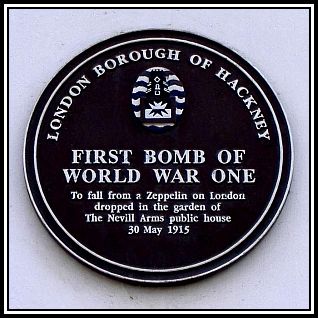
In the early summer of 1915, London suffered an attack from the air. This resulted in the authorities darkening the streets and forbidding church bells to be rung. On the 13th June, 1917, London suffered its first daylight air raid. A press campaign began in an attempt to convince Londoners to take shelter, and people believed that the safest place would be the Oxford House basement, rather than their own homes.

On the 4th September, 1917, the first night air raid occurred and about 50 people sought sanctuary there. The numbers rose to about one thousand five hundred by 29th September, 1917. Obviously, Oxford House could not manage such a number, and so a rule was made that only women and children could be admitted, but fathers were allowed to accompany their families.
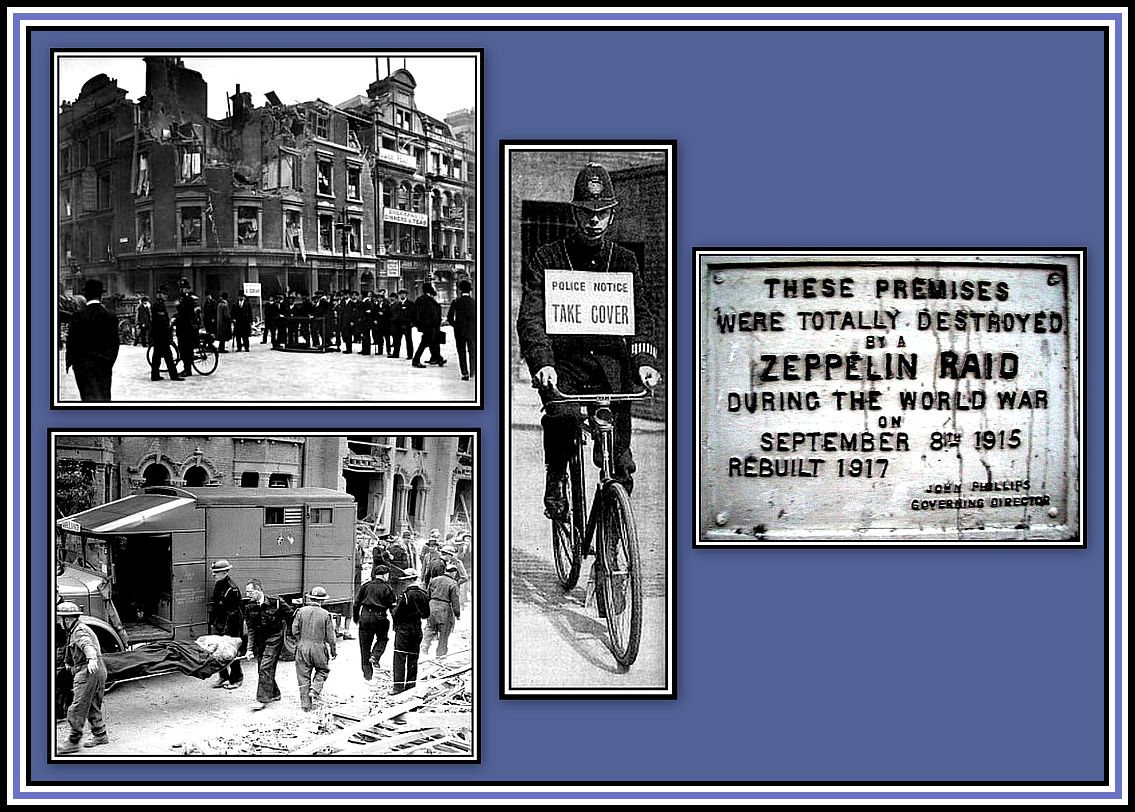 Bombing the East End during World War I
Bombing the East End during World War I
-oOo-
OXFORD HOUSE: THE POST FIRST WORLD WAR YEARS

Following the end of The First World War, it soon became apparent that Oxford House would not be able to return to its former position held in Bethnal Green unless it could obtain volunteer workers. This could not be done until Oxford University began to graduate students with a wish to volunteer.
The Council of Oxford House agreed that in order to maintain its place in the future, The House needed to be modern and up-to-date. In order to attract graduates, plans were made to set up a Church Continuation School at The Webbe Institute with living quarters at Oxford House where they would be asked to volunteer their services during the evenings. For graduates wishing to take Holy Orders, plans were made to house them at University House in Victoria Park Square. Unfortunately, both of these plans fell through, and by 1921, had been given up.
In 1922, there was still insufficient residents at Oxford House in order to revive all of the pre-war activities. A report from 1923 stated clearly that The Council had given up expecting a sudden rush of would-be residents to fill The House.
By 1924, The Council finally accepted the fact that times had changed: whereas before The First World War, there were many more men who were able to afford the time and money necessary for spending some months in Bethnal Green, as an additional preparation for their life’s work, now, after the war, the number of such men had evidently decreased. Despite great efforts on the part of The Council and those who continued to support the ideals of Oxford House, this situation would continue.
-oOo-
Although many of the Clubs were revived following the First World War, the world was undergoing great changes in all areas of life. As a result, Oxford House increasingly turned to politics and social questions and searched for ways to be of immediate practical service to the community. This began in 1921 with the opening of a Day Nursery and also in provided sports facilities for the unemployed.
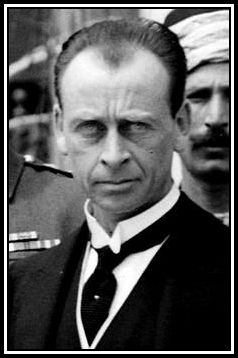 Sir Wyndham Deedes
Sir Wyndham Deedes
Sir Wyndham Deedes (1883-1956) came to Oxford House as a resident in 1923 and became Vice Head in 1926. During his time at The House, he started the Book and Picture Club that was aimed at children between the ages of 14- and 18-years of age in the hope of simulating interest in intellectual and artistic subjects. A Reading and Art Centre was opened in 1925 in the bookshop at Oxford House and was run in close co-operation with Bethnal Green Public Library. In 1927, drawing, fretwork, drama and folk dance classes were added to The Club.
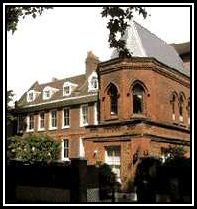 University House on Victoria Park Square where Sir Wyndham Deedes lived
University House on Victoria Park Square where Sir Wyndham Deedes lived
here between 1923 and 1939
-oOo-
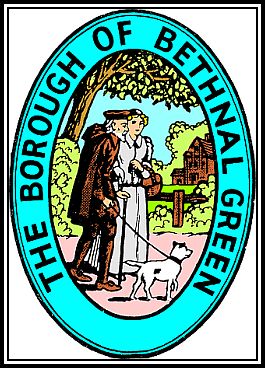 The Seal of the Metropolitan Borough of Bethnal Green showing The Blind Beggar
The Seal of the Metropolitan Borough of Bethnal Green showing The Blind Beggar
Bethnal Green, like so many other constituencies in the U.K. was supportive of Liberal policies at this time. Mr. Michael Seymour (?-1936) served Oxford House for over a quarter of a century as Secretary, Bursar and Head, and in 1925, stood for election as a Borough Councillor as an Independent since it was believed that Oxford House should not be associated with any one Political Party.
In 1927, the then-present Bethnal Green Council had a Labour majority. The majority of Council Members were said to be divided into Communists and Orthodox Labour who worked and voted together. However, the Labour members were always swayed by the Communists. Later it became evident that a split had occurred between the two groups and rival candidates were selected for future contests. It was uncertain whether the split would be healed in time for the election of a Mayor. As a result, the Constitutionalists felt they ought to have a nominee in readiness of such an event and selected Mr. Seymour to run. After a great deal of confusion, the Communist candidate was eliminated and Mr. Seymour received more votes and was duly elected.

At this time, questions were being asked about Oxford House’s involvement in local politics and if it was neglecting the religious side of its work.
-oOo-
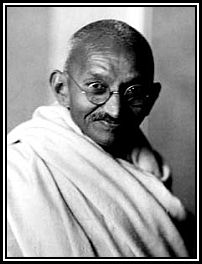 The Mahatma
The Mahatma
The Mahatma, Mohandas Ghandi (1869-1948) visited Oxford House during his trip to the U.K. in 1931. Apparently, he asked especially to speak in the intimate atmosphere of the Common Room rather than in a Public Hall. Many social workers attended the meeting, and the news of his presence spread through Bethnal Green, bringing a crowd of two or three thousand gathering outside. Mr. Ghandi was enthusiastically cheered, but it was noted by some that it was not easy to say whether they were brought there by sympathy or curiosity. As a Bethnal Green-ite, I do not doubt the sincerity of the crowd!
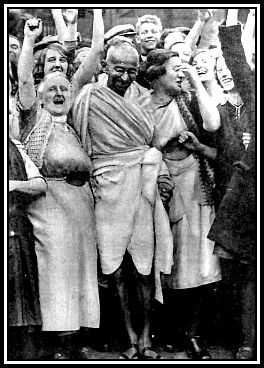 Mr. Ghandi with Textile Workers in Lancashire during his Trip to the U.K. in 1931
Mr. Ghandi with Textile Workers in Lancashire during his Trip to the U.K. in 1931
-oOo-
By the mid 1930’s, Oxford House had become an important centre of Social Work. By this time, there were only fifteen Clubs of any kind in Bethnal Green, five of which were associated with Oxford House and, three of these were Political Clubs.

The 1930’s saw high unemployment throughout the western world. Bethnal Green seemed to be especially hard hit as many of the male population was without work. As a result, Oxford House opened an Unemployment Centre in 1933 at The Webbe Institute, but was later moved to The Repton Buildings. Each member, unless physically incapable, was required to do an hour of training in either the Boxing Room or the Gymnasium. This requirement was not accepted by a segment of society and the police had to be called to restrain them.
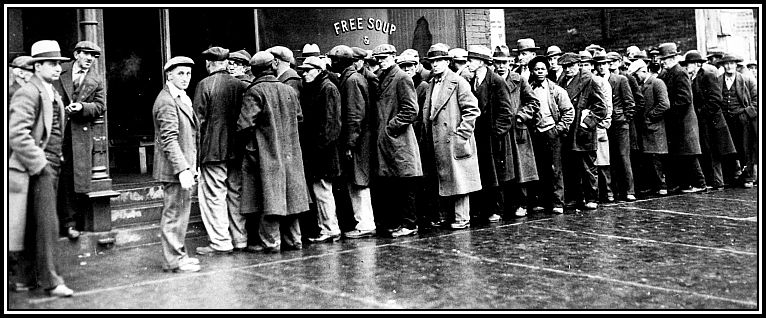 Unemployment
Unemployment
Unfortunately, the period between the two World Wars was a time of political upheaval, antagonism and mistrust. The division between the working class and the rest of society widened. As a result, the social work hoped to be carried out at Oxford House suffered and the division between the classes worsened further in 1926 with the calling for The General Strike, which lasted between 4th and 13th May.
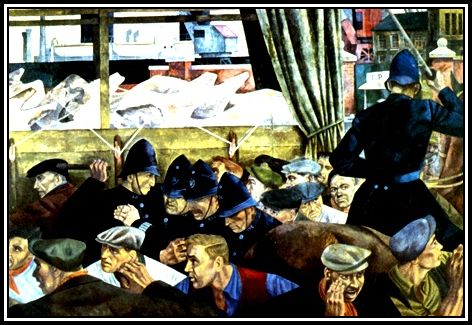 The General Strike Mural by Cliff Rowe (1904-1989)
The General Strike Mural by Cliff Rowe (1904-1989)
Although feelings of antagonism and mistrust receded with time, unemployment was still high in Bethnal Green in 1933.
In 1934, elections for the London County Council and for the Borough Council were held and each seat was won by a Socialist. Prior to this, there had been two Independent members on the Borough Council, who were the Rector of Bethnal Green and the Head of Oxford House.
-oOo-
During the 1930’s, various areas of the East End, especially Bethnal Green and Stepney, were targeted by Osward Mosley (1896-1980) and his Fascist propaganda. Mosley had once been a member of the Labour Party, but due to differences of opinion, he left the Party and formed The New Party in 1931. He dissolved The New Party in 1932 once he discovered, what he considered to be, the virtues of Fascism and the policies of Mussolini (1883-1945) and Hitler (1889-1945) and worked to unite the existing fascist movements and created the British Union of Fascists (BUF) in 1932.
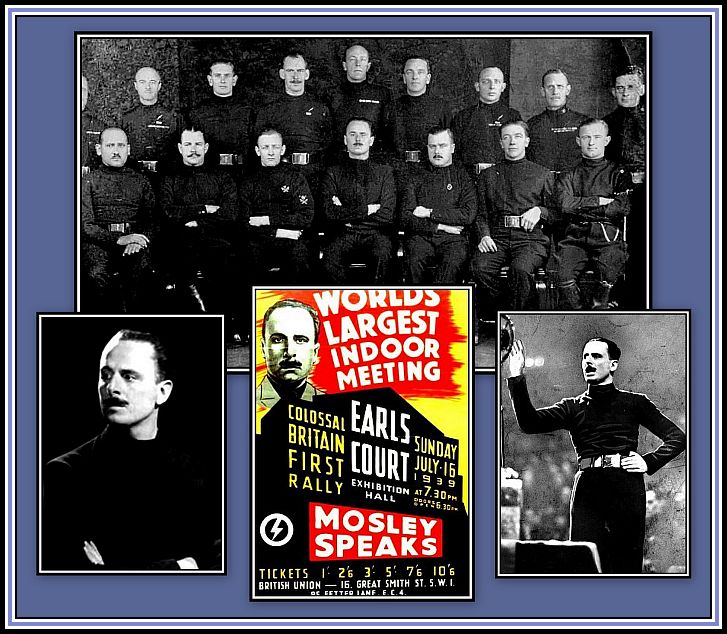 Oswald Mosley & The Blackshirts
Oswald Mosley & The Blackshirts
Mosley sought to take advantage of the huge unemployment present in the U.K. during the 1930s and organised rallies and marches. In October 1936 he and the BUF attempted to march through Stepney, which had many Jewish residents. The result was a violent interaction between supporters of the BUF, the Metropolitan Police and protesters (including local Jewish, Socialist, Anarchist, Irish and Communist Groups), which has since become known as, The Battle of Cable Street. The protesters were united by the call, They shall not pass, which had been used by the anti-fascist forces during the Spanish Civil War, ¡No Pasarán! and succeeded in not allowing Mosley & The Blackshirts to pass despite vigorous police oppositon.
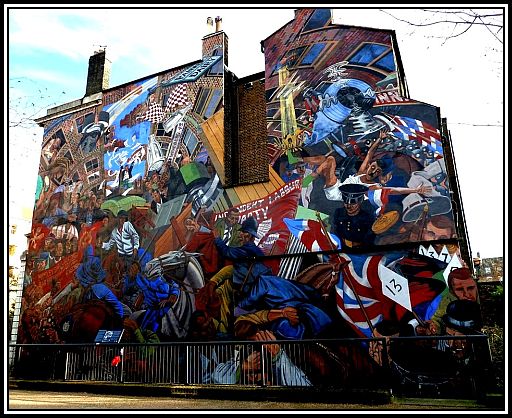 Mural depicting The Battle of Cable Street found on a side wall of St. George’s Town Hall
Mural depicting The Battle of Cable Street found on a side wall of St. George’s Town Hall
The painting was started in 1976 by Dave Binnington and completed
by Paul Butler, Ray Walker and Desmond Rochfort in 1983 and was restored in 2011
Although there were many who did not agree with the policies of Mosley and his dislike of Jews, others found the presence of the greater number of police in the area to help maintain order nothing more than an annoyance. Sadly, many of the young found the idea of violent interaction to be great fun and a good lark!
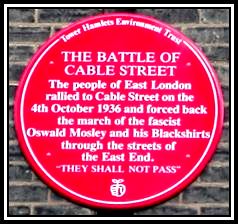
-oOo-
OXFORD HOUSE: 1937 & 1938
GETTING MORE IN TUNE WITH SOCIETY
Oxford House had suffered from a number problems in the past, which ranged from:
- periodic difficulties in finding the necessary number of Oxford graduates willing to spend time at The House;
- differences of opinions with the local Clergy regarding the attempts of The House to evangelise members of the community; and
- problems maintaining The House on a firm financial footing.
Despite difficulties experienced in the past, The House managed to continue offering its services to the local community. At this time, Mr. John Lewis had taken over as Head of The Council.
The Oxford House Annual Report of 1937 appears to have been one of particular importance in the history of The House since it included a number of plans that would have direct impact on its future functioning .
These included a plan to help ensure the continuation of the religious basis of The House, as well as plans to become, perhaps, more in tune with the changing society it now found itself a part.
- The Council took note that people were finding their daily work to be mechanical and uncreative and were looking for ways to employ their leisure time in a more creative manner. The Officials believed that Oxford House could offer opportunities to achieve this with some modenisation to better help those in need. As a result, it was proposed to build a modern and well-equipped Hall adjacent to The House.
In 1938, the additional land was purchased and the considerable monies were obtained towards the venture. The first part of the work was the construction of a new centre on the site of Oxford Hall and some of the adjacent properties that had been acquired.
Unfortunately with the outbreak of The Second World War, when the large grant offered by the National Fitness Council was withdrawn, the plan collapsed, leaving The House with the bare site and an account to be paid for the plans of the proposed buildings.
-oOo-
- Until this time, Oxford House was seen by many as a Batchelor Retreat. However, the current Head of Oxford House, Mr. ? Lewis, was the first Head to be married and the top floor of The House had been converted into living quarters for them. In addition, the Matron and the Cook, both of whom were female, also lived at The House.
Early in 1937, a piece in The Excelsior Magazine noted that mixed activities in Clubs had already occurred and that dances had been held at The House and mixed-dramatics at Excelsior Hall. The article continued to say that Oxford House had gone a certain way with the mixed activities, which seemed to be in tune with present-day social custom. As a result, as the author said, The Council did not contemplate leaping from that to mixed clubs, so let no one take alarm.
By 1938, the Council discussed whether to invite women to be residents at The Settlement and also to allow mixed activities into The Clubs. However, there was a difference of opinion on these subjects.
-oOo-
- The Annual Report of 1937 also makes note of efforts to once more set up a Training Scheme for Ordinals. Such an efforts had been made previously, but had been discontinued in 1936. The Scheme was to instruct in the techniques used in the teaching of religious subjects and also in supervision and practice for application in Sunday Schools. The Scheme was also to help train those enrolled in the practical needs of the locals and allow them to experience them. Apparently there were ten candidates enrolled during the first year and fourteen in the next.
-oOo-
The Annual Report of 1938 makes note of the fact that there were now three lawyers, as opposed to one, which had been the case until then, associated with the Poor Man’s Lawyer Department.
-oOo-
With the declaration of The Second World War, many of the proposals and efforts of The Council were suspended including The Training Scheme for Ordinals.
In a Memorandum from 1939, Mr. Lewis suggested that:
We are now at the parting of the ways — we can either proceed to die gently and peacefully in the course of the next ten years or so, or enter on a period of intensive activity, which well might be considered the refounding of the House.
-oOo-
OXFORD HOUSE: THE SECOND WORLD WAR
The declaration of war saw the founding of two special Clubs at Oxford House:
- The war saw an increase in demand to allow girls to join some of the Boys’ and Men’s Clubs. In 1940, a Girls’ Club was founded at Oxford House with the approval of the local women’s settlements. Various activities were organised for the girls and, on Wednesdays and Saturdays, dancing was allowed where boys and girls were able to dance together.
- A number of Club Members were soon constricted for military service and were therefore unable to take part in the activities of The Clubs. In order to offers these members with a link to Oxford House, The Unseen Club was formed for such men. By 1941, ~500 servicemen stationed all over the world were members of this Club. Members were kept informed of what was happening in Bethnal Green and in the various Clubs, as well as helping old friends stay in touch through a publication, called Club News from Bethnal Green. At its peak, The Unseen Club had over 900 members.
-oOo-
The early years of The Second World War saw the revenue of Oxford House fluctuate greatly resulting in the deficit carried rising markedly. Despite this, the demands made on The House by the locals continued to increase with The Council doing its best to meet them.
 The Site of the First Flying Bomb (V2) to hit London was at the Railway Bridge over Grove Road in Bow
The Site of the First Flying Bomb (V2) to hit London was at the Railway Bridge over Grove Road in Bow
The East End suffered badly from bomb damage during The Second World War. Bethnal Green was close enough to The London Docks to also suffer much destruction and loss of life. People were obviously terrified by the sound of bomb explosions and also of returned gun fire. The sound of the new guns being fired from their place of installation in Victoria Park is believed to be one of the contributing factors that led to The Bethnal Green Underground Disaster of 3rd March, 1943 where 173 people were crushed to death.
 Plaque at Bethnal Green Underground Station making the site of The Disaster
Plaque at Bethnal Green Underground Station making the site of The Disaster
-oOo-
By 1942, the deficit had risen to £5,720. Oxford House arrived at this sum since it felt that it had to perform its duties immediately and consider payment later. In addition, there was few personal and essential no time available to raise money or even maintain subscription lists. The cost of running University House, which had grown in size, was also a large financial burden to Oxford House. In addition, the effect of the air raids had had an influence on the revenue of the Excelsior Kinema, and in 1941, the Kinema had had to ask if it might forgo payment of its rent.
1943 turned out to a better year for Oxford House. Firstly, enemy air raids occurred less often, which helped reduce the necessary expenditure of The House. The workers of Oxford House also made great efforts to raise funds and were suitably rewarded. The Excelsior Kinema was also able to pay its rent for the year, since people started going to the cinema once more. As a result, the accumulated deficit, although still high, had fallen to £4,644.
-oOo-
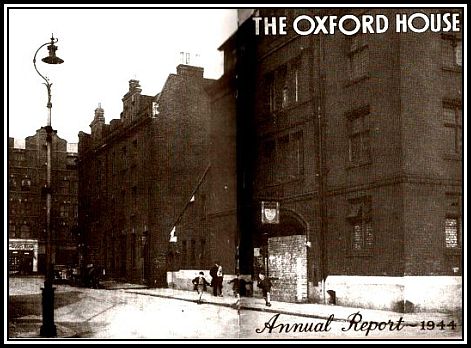
One of the direct results of the air raids was an increase in number of people made homeless with few or no possessions. Where possible, the homeless moved in with family members, however, there were many where this was not an option.
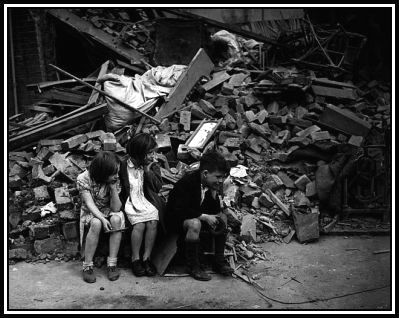 Homeless after an Air Raid
Homeless after an Air Raid
Oxford House was involved in a number of services to help fill the needs of the local population during the war years. Once again, The House served as a shelter during the air raids with room for some 300 people in the basement. Oxford House also became a registered Emergency Rest & Feeding Centre and was involved in the evacuation of the children of the area.
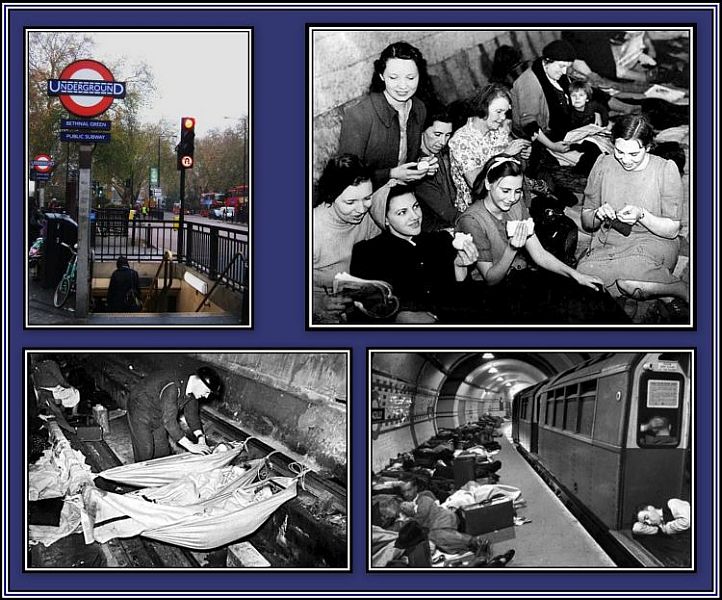 Emergency Shelter at Bethnal Green Underground Station
Emergency Shelter at Bethnal Green Underground Station
Oxford House also served to house homeless people while they awaited rehousing. In addition, the London Hostels Association working with Oxford House were able to open a hostel for 60 people at University House in Victoria Park Square.
-oOo-
With the advent of air raids involving Bethnal Green, the bombing not only made a number of people homeless, but left bombed sites where buildings once stood. This led to the formation of The Bombed Sites Producers’ Association, which set about converting these sites into allotments where people were able to grow vegetables for consumption.
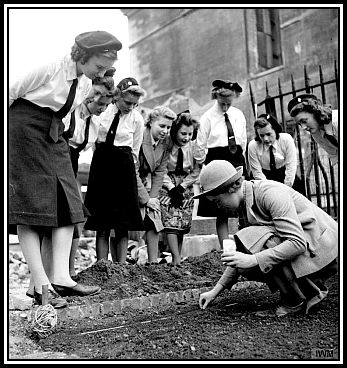
A Group of Schoolgirls being shown how best to plant seeds
I expect that the school uniforms and the teacher’s attire were for the benefit of the photograph
The Association produced a regular bulletin and, in the June 1943 issue, it stated that it was now responsible for ~300 cultivated allotments and for a scattered farm of 4,000 rabbits, 2,000 chickens, 9 goats, a pony and 10 pigs.
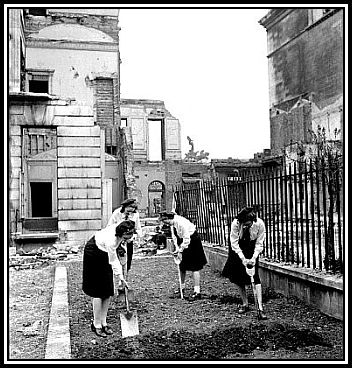 A Group of Schoolgirls help prepare a flower garden for the growing vegetables
A Group of Schoolgirls help prepare a flower garden for the growing vegetables
There seems to be some difference of opinion as to when the Association was formed. According to one source, it was founded in March 1942 when a group of children under the guidance of an Oxford House resident had set about clearing away the bricks, rubble and other debris from a bombed site in Russia Lane, which was then readied for cultivation. However, according to the book, A Green and Pleasant Land: How England’s Gardeners Fought the Second World War by Ursula Buchan, on the 21st September, 1941, the Duck of Norfolk, Bernard Marmaduke Fitzalan-Howard, the 16th Duke (1908-1975), visited a number of allotments and back yards to inspect hens and rabbits. This event was promoted by Mr. Roy Hay who persuaded the BBC to cover it and broadcast a piece about it during the evening.

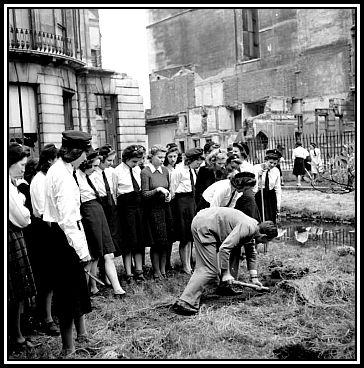
Mr. Roy Hay shows a group of School Girls the best way to turn over the earth
Later, on the 17th June, 1943, The Queen (1900-2002) visited Bethnal Green and visited an allotments and combined farm where she apparently saw lots of animals including chickens, rabbits, geese, pigs, a pony and a goat, which apparently ate the Dig for Victory leaflets that were planned for distribution! The animals were housed in sheds that had been constructed entirely from scrap. The Queen was accompanied on her visit by Sir Wynham Deedes, a former Head of Oxford House, who lived in Bethnal Green for the duration of the War.
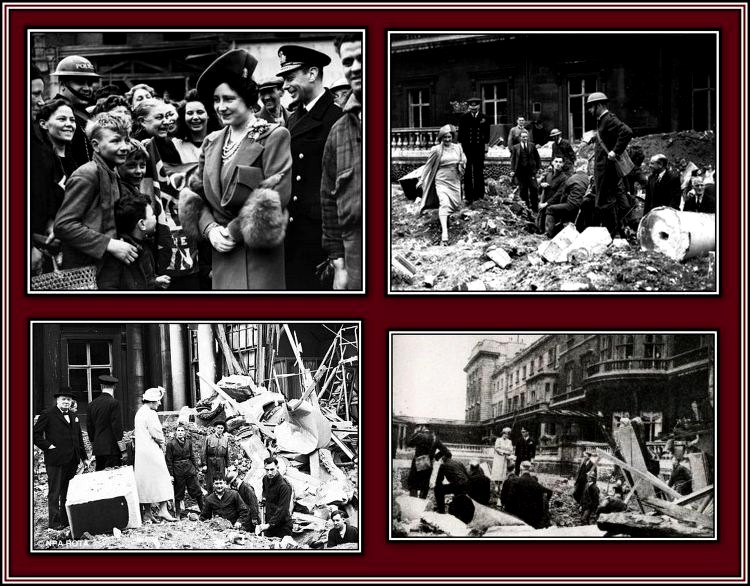 Top Left: The King & Queen visiting the East End
Top Left: The King & Queen visiting the East End
The remainder of the photographs show the bomb damage at Buckingham Palace
-oOo-
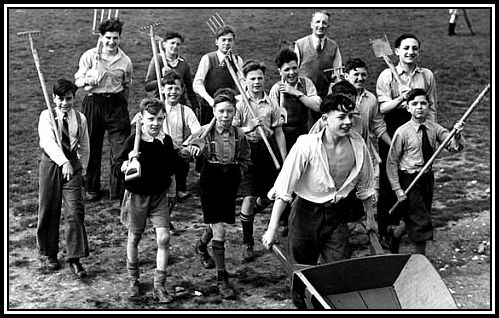 Boys also took part in the making of Allotments
Boys also took part in the making of Allotments
-oOo-
With the declaration of war, Women began to be called up and expected to do jobs previously done by men who were now serving in the military forces. With this, a need arose for nurseries where the children of these women could be taken and cared for while their mothers performed these duties. A Play Centre was opened at Oxford House for small children, and, in 1940, a Nursery Centre was opened at University House. There was always a long waiting list for entry into both facilities.
-oOo-
OXFORD HOUSE: A PERSONAL CONNECTION
My mother went to work for British Railways during the war and was required to drive a team of horses and cart and make deliveries in the City of London and around The London Docks. She was based at the office and sheds that were to the left of Aldgate Bus Station, across the road from Aldgate Underground Station. Today, the sheds and office have been demolished leaving the area as an empty space with a statue at its centre.
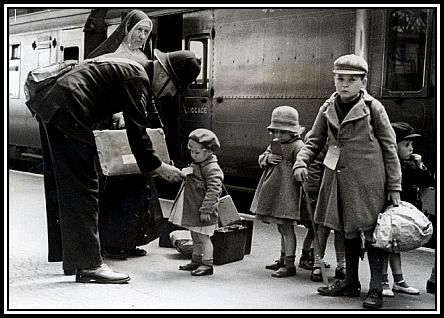 Children being evacuated from London
Children being evacuated from London
When my mother became pregnant, she was denied evacuation since her work for British Railways was considered necessary to the War Effort! As a result, for the first few years of my life, I too was at the mercy of Dooblebugs and then the V2 Rockets. Still, things could have been worse when you think that so many children, at this time, were in prison camps!
I was born in 1943, and after two months, my mother had to return to work and I went to the Nursery Centre at University House and remained there until 1945. Believe it or not, I actually have a few memories of my time at The Centre. I remember a woman telling me that I was supposed to be with The Tweenies and not with some other group of children! I am convinced that this resulted in my not enjoying being labelled!
While I attended The Centre, Princess Margaret (1930-2002) came to visit and also to judge a Baby Show. I am greatly amused about this, as I won the competition and was presented to the Princess, who, so I am told, took a great shine to me while giving me my prize.
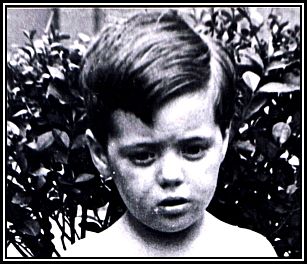 As the reader can see, I was not an especially happy child at this time
As the reader can see, I was not an especially happy child at this time
I am told that I had no interest in the her since I had buried a possession in the garden and was more interested in retrieving it rather than spending time talking to this lady! Seemingly, her visit was covered by a number of newspapers and a huge photograph of me appeared in one of the large windows of the Daily Express building on Fleet Street for several months.
My mother often had to work longer hours than her regular shift. This caused her to be too late to pick me up at the Day Nursery. Once it closed, unclaimed babies were taken to the local Police Station to await their mothers.
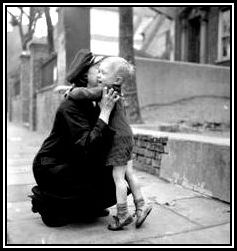 Railway Worker picking up her son at a Day Nursery after finishing her deliveries
Railway Worker picking up her son at a Day Nursery after finishing her deliveries
Apparently, I was always the last child to be claimed, but my mother always found me well-cared for and the centre of attention! My mother said that I was always surrounded by a ring of policemen who were laughing heartily at my antics. They always plied me with biscuits and sweets once I was able to take solid foods. Oftentimes this led to my face and hands being covered with chocolate. They also liked to attempt to place one of their helmets on my head, but this only served to slip down and hide my face since it was too big for me to actually wear. Naturally this caused the policemen to laugh even more!
Click here to hear the old Music Hall song, The Laughing Policeman
-oOo-
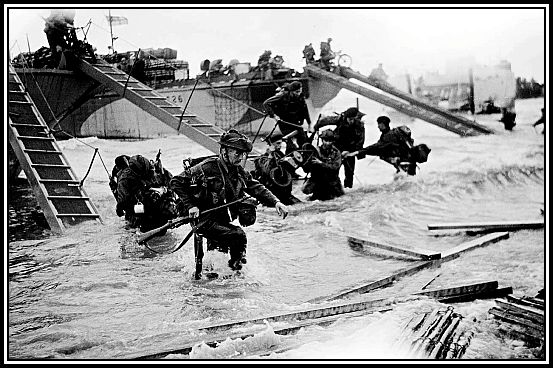
On the 6th June, 1944 (D-Day), allied forces launched a series of landings on the Normandy coast, with the codename Operation Neptune, to gain a foothold on the shores of Continental Europe and begin its liberation. This was considered by many to be the beginning of the end of the Second World War. Sadly for everyone involved, the movement forward towards Berlin and the defeat of Hitler and the Nazi Regimen (1933-1945) was fraught with setbacks along with the victories until the War in Europe finally came to its official end in countries West of Germany on the 8th May, 1945 (V.E. Day) and on the 9th May in countries East of Germany. This difference was the result of the time differences between the U.S.S.R., the U.S.A. and Western Europe.
From 1940 until 1944, The Headship of the Council was held by Guy Clutton-Brock (1906-1995) who ran Oxford House with the aid of a number of Conscientious Objectors. He resigned as Head in early 1945 to take up a position working for the religious and educational rehabilitation of Germany.
During the Second World War Years, Oxford House appeared to be even more involved with the local neighbourhoods and, as a result, appeared to be more accessible to the people, although this had always been the aim of the Settlement.
Many saw these activities as signs that Oxford House was acting very much like a Community Centre.
-oOo-
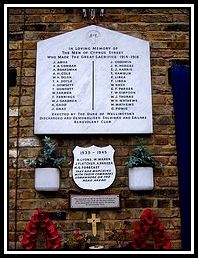 War Memorial in Cyprus Street, Bethnal Green
War Memorial in Cyprus Street, Bethnal Green
-oOo-
OXFORD HOUSE: THE POST SECOND WORLD WAR YEARS
THE TIMES CONTINUE TO CHANGE
In 1944, Oxford House began to make provision for the return of local Club-members who were currently serving in the armed forces. This was done by launching a special appeal. The monies collected were to be used for this purpose and also to help reduce the financial deficit.
Mr. john Illsley who was the Vice-Head of The Council from 1941 until early in 1945 when Mr. Guy Clutton-Brock resigned was appointed Acting-Head while a successor was sought.
By now, Oxford House was being seen by many as practically functioning as a fully-fledged Community Centre and this caused Mr. Illsley to comment on this:
My own feeling is that Oxford House has always been a community centre, but that we are now becoming widely recognised as such by the neighbourhood which we serve. Oxford House has endeavoured to cater for all sections of the community, although it is not always clear what the exact needs of the locality are going to be—not what they are, because we always have had to plan ahead.
-oOo-
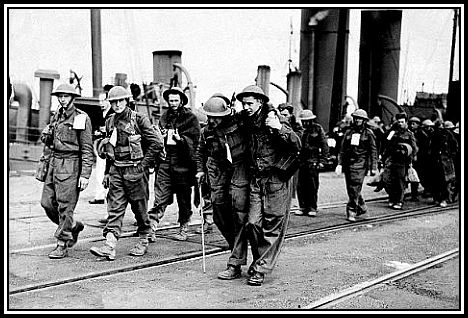
The end of the Second World War brought with it a number of changes to the routine activities of Oxford House and these included the following:
- with the demobilisation of the troops, membership to The Unseen Club began to lessen;
- although by now, The House had ceased to be used as a shelter, a number of women who had sought refuge here and had enjoyed meeting each other asked if they might continue to do so. This was allowed and they began to meet three nights a week;
- the junior clubs, for both boys and girls, were re-opened;
- The Webbe Boys’ Club, which had shared the premises of the Men’s Club, now moved back to their own facility. The building was in a poor state and in need of repair, which was undertaken mostly by the boys themselves;
- The Bombed Sites Producers Association now based in The House began to devote its attention to the provision of gardens around the Pre-Fabricated Houses, which were now beginning to occupy the sites of former allotments;
- The House had become the home of a number of local organisations and acted as Headquarters for the local branch of The British Legion.
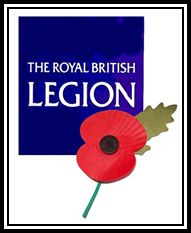
-oOo-
It is amazing to think that some 80 tons of bombs fell on Bethnal Green causing devastation throughout the Borough . Fortunately Oxford House was not hit during the air raids.
In 1957, the authorities decided that the small houses of Mape and Derbyshire Streets, including the original Oxford House, should be demolished to allow replacement by a green area. The area was completed in 1967 and was named Weaver’s Fields.
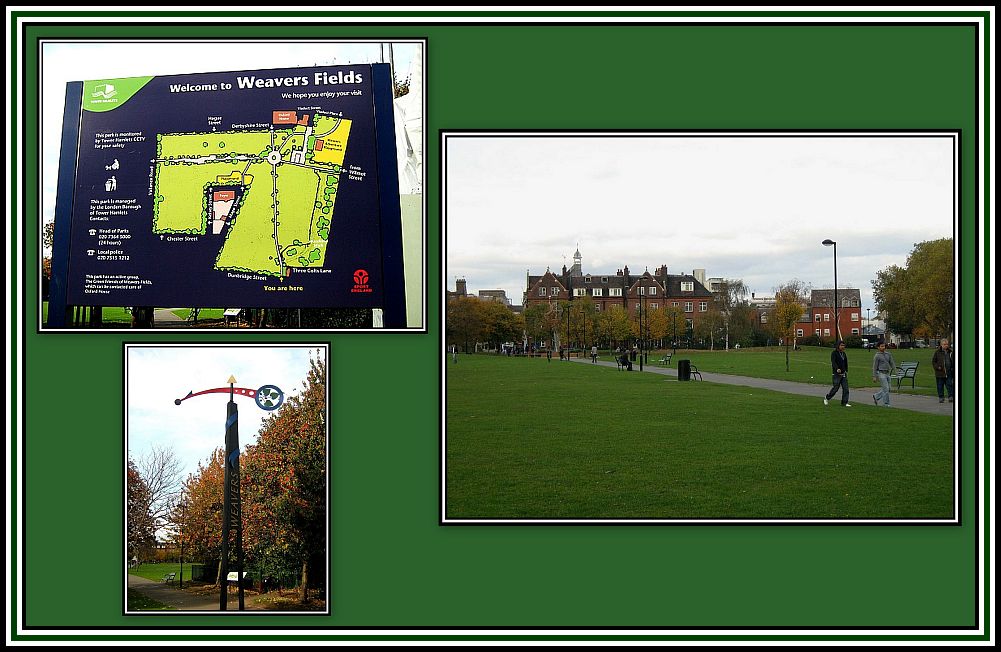 Weaver’s Fields with Oxford House in the background
Weaver’s Fields with Oxford House in the background
To read more of the renovation and restoration of the area, I recommend the article :
Post War Regeneration of Bethnal Green by Ms Laura Newby of Oxford House
——oooOOOooo——
——oooOOOooo——
Readers can TWEET their LIKES & DISLIKES to me at
or
make comments on the Website’s FACEBOOK PAGE
or
consider leaving a Comment below.
——oooOOOooo——
ACKNOWLEDGEMENTS
I would like to thank the author(s) of The Oxford House in Bethnal Green (1884-1948), which provided much of the material detailed here. I would like to thank Mr. John Ryan and Ms Maja Bevk of Oxford House (OH!) for their help in the preparation of this series.
——oooOOOooo——
——oooOOOooo——
——oooOOOooo——
——oooOOOooo——
——oooOOOooo——


Hello, I stumbled across your web pages whilst looking up something about Mick Mason (Harworth organ) and started reading a little deeper.
One article caught my eye – the one connected with the Zeppelin raids on London.
I’m a Derbyshire boy (1948 vintage) but my maternal Grandmother was born and brought up in Bethnal Green. I remember her telling me of one day being taken to the house door by her father, and seeing a Zeppelin that had been hit and was on fire. She could see the bodies of German soldiers falling out of it and her father’s words were something to the effect of “Look Masie, them’s some Mothers’ boys.” None of this “Look, some more Germans being killed”. It’s something that sticks in my mind whenever I think of war.
Grandma was born in 1894, and so would have been in her 20’s
At about the same time, she was out with another local young lady when they met with a couple of lads in “Hospital blue”. One was a Jonathon Kirk from Chesterfield – he’d got a shrapnel wound and was back in Blighty for treatment. Well, the relationship blossomed and May Jennings became May Kirk, resulting in firstly my Uncle (another Jonathon) and then my own Mum, who became May Young.
Grandad Kirk would never speak of what happened during WW1. He served with Kings Own Scottish Borderers (despite having no Scottish blood) and his medals were thrown into a drawer at their home. They just “went missing” one day and I often wonder if they were stolen or sold – he wouldn’t say.
Having visited a number of the battlefields fought over in WW1, I can understand why some soldiers didn’t speak of their time fighting.
I also wonder what he’d have said about my cousin Helen (his only grand daughter) as she studied German at University and now lives near Freiburg with a wonderful German husband and 2 lovely German children.
Best wishes,
Ron Young, Whitwell, Derbyshire